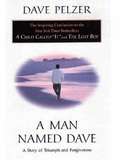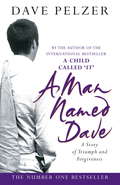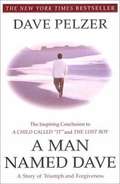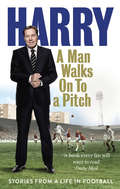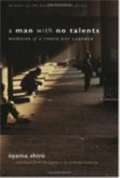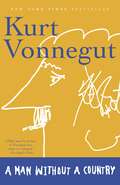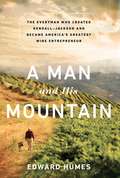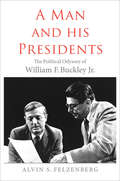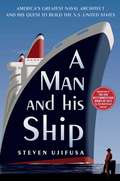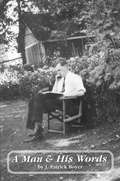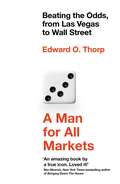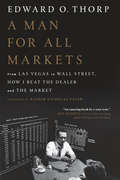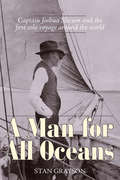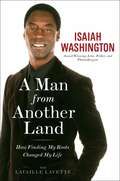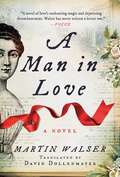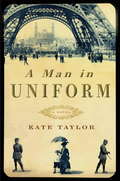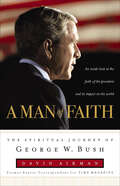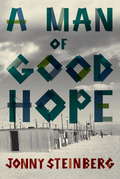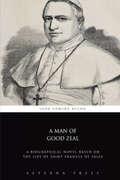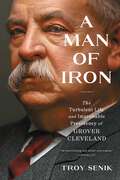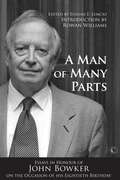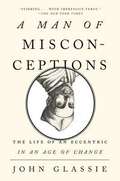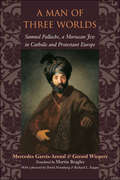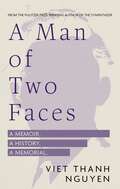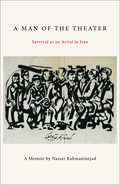- Table View
- List View
A Man Named Dave
by Dave PelzerThe inspiring conclusion to the New York Times bestselling series that includes A Child Called 'It' and The Lost Boy Dave Pelzer's incredible and inspiring life story has already captured the interest of more than one million readers. A Man Named Dave is the long-awaited conclusion to his trilogy in which he describes how he triumphed over years of physical and emotional abuse from his parents to become a self-accepting and confident adult. Readers of Pelzer's previous two bestsellers await this book--the first of Pelzer's books to be available in hardcover--to learn how he finally confronts his pathologically abusive mother and his neglectful, alcoholic father in an effort to turn a childhood marked by rejection and emotional abuse into an adulthood filled with love and acceptance. * Dave Pelzer's first two books have been on the New York Times bestseller list for more than one hundred weeks combined * The first two books in this trilogy have been translated into ten languages A Child Called 'It' was so riveting, neither I nor my staff could put it down! Dave Pelzer's story does not focus on his life-threatening plight as much as his unyielding determination that inspires us all. Dave is a living example that all of us have the capability to better ourselves no matter what the odds. One's life is forever changed after living through the eyes of A Child Called 'It'. --Jack Canfield, coauthor of Chicken Soup for the Soul The Lost Boy stands shining as the premier book on the unique love and dedication that social services and foster families provide for our children in peril. Dave Pelzer is certainly a living testament of resilience, personal responsibility, and the triumph of the human spirit. --John Bradshaw, bestselling author of Homecoming.
A Man Named Dave: A Story Of Triumph And Forgiveness
by Dave PelzerThe concluding volume of Dave Pelzer's million-copy bestselling memoir.'I don't blame others for my problems. I stand on my own. And one day, you'll see, I'm going to make something of myself.' These words were eighteen-year-old Dave Pelzer's declaration of independence to his mother, a woman who had abused him with shocking brutality. But even years after he was rescued, his life remained a continual struggle. Dave felt rootless and awkward, an outcast haunted by memories of his years as the bruised, cowering 'It' locked in his mother's basement. Dave's dramatic reunion with his dying father and the shocking confrontation with his mother led to his ultimate calling: mentor to others struggling with personal hardships. From a difficult marriage to the birth of his son, from an unfulfilling career to an enduring friendship, Dave was finally able to break the chains of his past, learning to trust, to love, and to live.
A Man Named Dave: A Story of Triumph and Forgiveness
by Dave Pelzer"All those years you tried your best to break me, and I'm still here. One day you'll see, I'm going to make something of myself." --Dave Pelzer, from A Man Named Dave. These words were Dave Pelzer's declaration of independence to his mother, and they represented the ultimate act of self-reliance. Dave's father never intervened as his mother abused him with shocking brutality, denying him food and clothing, torturing him in any way she could imagine. This was the woman who told her son she could kill him any time she wanted to--and nearly did. The more than two million readers of Pelzer's previous international bestsellers, A Child Called "It" and The Lost Boy, know that he lived to tell his courageous story. A Man Named Dave is the gripping conclusion to his inspirational trilogy. With stunning generosity of spirit, Dave Pelzer invites readers on his journey to discover how he turned shame into pride and rejection into acceptance.
A Man Walks On To a Pitch: Stories from a Life in Football
by Harry Redknapp‘When a man walks on to a pitch there’s always a chance something magic can happen, that’s what keeps us coming back…’In A Man Walks On To a Pitch, Harry shares a lifetime’s experience of obsessing over football, during which he has seen it all first hand – the good, the bad and the unbelievable. Harry started in an age where players were ordinary blokes who might live on the same street as you and earn a similar wage. Now he manages in an era of player power, multi-million pound wages and teams assembled from around the globe.As he shares stories of some of the legends and journeymen he played, coached, argued and drank with, Harry picks a team for each decade from the 1950s to the present. He gets to the heart of what was right and wrong with each era and explores the changes in the game from lifestyle to tactics. He weaves his choices together with unforgettable tales from the training pitches, boot rooms and card schools.There are tales of the untutored genius of Duncan Edwards and Tom Finney, legendary tough Scots like Bobby Collins, Dave Mackay and Billy Bremner, the world-beaters of 1966, unpredictable one-off wizards from Sir Stanley Matthews to Matt Le Tissier, natural-born goalscorers from Greaves to Dalglish and the greatest foreign players to grace our game from Trautmann to Bergkamp. It is one of the best informal histories of the British game you’ll ever read.
A Man With No Talents: Memoirs Of A Tokyo Day Laborer
by Oyama Shiro Edward FowlerSan'ya, Tokyo's largest day-laborer quarter and the only one with lodgings, had been Oyama Shiro's home for twelve years when he took up his pen and began writing about his life as a resident of Tokyo's most notorious neighborhood. After completing a university education, Oyama entered the business workforce and appeared destined to walk the same path as many a "salaryman." A singular temperament and a deep loathing of conformity, however, altered his career trajectory dramatically. Oyama left his job and moved to Osaka, where he lived for three years. Later he returned to the corporate world but fell out of it again, this time for good. After spending a short time on the streets around Shinjuku, home to Tokyo's bustling entertainment district, he moved to San'ya in 1987, at the age of forty. <p><p> Oyama acknowledges his eccentricity and his inability to adapt to corporate life. Spectacularly unsuccessful as a salaryman yet uncomfortable in his new surroundings, he portrays himself as an outsider both from mainstream society and from his adopted home. It is precisely this outsider stance, however, at once dispassionate yet deeply engaged, that caught the eye of Japanese readers. <p> The book was published in Japan in 2000 after Oyama had submitted his manuscript--on a lark, he confesses--for one of Japan's top literary awards, the Kaiko Takeshi Prize. Although he was astounded actually to win the award, Oyama remained in character and elected to preserve the anonymity that has freed him from all social bonds and obligations. The Cornell edition contains a new afterword by Oyama regarding his career since his inadvertent brush with fame.
A Man Without a Country
by Kurt VonnegutNEW YORK TIMES BESTSELLER“[This] may be as close as Vonnegut ever comes to a memoir.” –Los Angeles Times“Like [that of] his literary ancestor Mark Twain, [Kurt Vonnegut’s] crankiness is good-humored and sharp-witted. . . . [Reading A Man Without a Country is] like sitting down on the couch for a long chat with an old friend.” –The New York Times Book ReviewIn a volume that is penetrating, introspective, incisive, and laugh-out-loud funny, one of the great men of letters of this age–or any age–holds forth on life, art, sex, politics, and the state of America’s soul. From his coming of age in America, to his formative war experiences, to his life as an artist, this is Vonnegut doing what he does best: Being himself. Whimsically illustrated by the author, A Man Without a Country is intimate, tender, and brimming with the scope of Kurt Vonnegut’s passions.“For all those who have lived with Vonnegut in their imaginations . . . this is what he is like in person.” –USA Today“Filled with [Vonnegut’s] usual contradictory mix of joy and sorrow, hope and despair, humor and gravity.” –Chicago Tribune“Fans will linger on every word . . . as once again [Vonnegut] captures the complexity of the human condition with stunning calligraphic simplicity.” –The Australian“Thank God, Kurt Vonnegut has broken his promise that he will never write another book. In this wondrous assemblage of mini-memoirs, we discover his family’s legacy and his obstinate, unfashionable humanism.” –Studs Terkel
A Man and His Mountain: The Everyman who Created Kendall-Jackson and Became America's Greatest Wine Entrepreneur
by Humes9781610392853
A Man and His Presidents: The Political Odyssey of William F. Buckley Jr.
by Alvin FelzenbergA new understanding of the man who changed the face of American politics William F. Buckley Jr. is widely regarded as the most influential American conservative writer, activist, and organizer in the postwar era. In this nuanced biography, Alvin Felzenberg sheds light on little-known aspects of Buckley’s career, including his role as back-channel adviser to policy makers, his intimate friendship with both Ronald and Nancy Reagan, his changing views on civil rights, and his break with George W. Bush over the Iraq War. Felzenberg demonstrates how Buckley conveyed his message across multiple platforms and drew upon his vast network of contacts, his personal charm, his extraordinary wit, and his celebrity status to move the center of political gravity in the United States closer to his point of view. Including many rarely seen photographs, this account of one of the most compelling personalities of American politics will appeal to conservatives, liberals, and even the apolitical.
A Man and His Ship: America's Greatest Naval Architect and His Quest to Build the S.S. United States
by Steven UjifusaTHE STORY OF A GREAT AMERICAN BUILDER At the peak of his power, in the 1940s and 1950s, William Francis Gibbs was considered America's best naval architect. His quest to build the finest, fastest, most beautiful ocean liner of his time, the S.S. United States, was a topic of national fascination. When completed in 1952, the ship was hailed as a technological masterpiece at a time when "made in America" meant the best. Gibbs was an American original, on par with John Roebling of the Brooklyn Bridge and Frank Lloyd Wright of Fallingwater. Forced to drop out of Harvard following his family's sudden financial ruin, he overcame debilitating shyness and lack of formal training to become the visionary creator of some of the finest ships in history. He spent forty years dreaming of the ship that became the S.S. United States. William Francis Gibbs was driven, relentless, and committed to excellence. He loved his ship, the idea of it, and the realization of it, and he devoted himself to making it the epitome of luxury travel during the triumphant post-World War II era. Biographer Steven Ujifusa brilliantly describes the way Gibbs worked and how his vision transformed an industry. A Man and His Ship is a tale of ingenuity and enterprise, a truly remarkable journey on land and sea.
A Man and His Words
by J. Patrick BoyerRobert Boyer was a consummate Canadian, whose long career can be measured by words. An author, journalist, researcher, editor, printer, and public speaker, Boyer’s professional life began at the age of 19 when he became a newspaper editor, and continued through the publication of his twelfth book at the age of 88. He was also a church organist, a member of the Ontario Legislature for seventeen years, and the first vice-chairman of Ontario Hydro. A Canadian Shield Book Published by Dundurn in partnership with Canadian Shield Communications Corporation.
A Man for All Markets: Beating the Odds, from Las Vegas to Wall Street
by Edward O. ThorpA New York Times bestseller In a remarkable career, Edward O. Thorp rose up from nothing to become a professor at MIT, invented card counting and the world&’s first wearable computer, beat the casinos of Las Vegas at blackjack and roulette, then became a bestselling author and a hedge fund heavyweight, ushering in a revolution on Wall Street. Now he shares his incredible life story for the first time, revealing how he made his fortune and giving advice to the next generation of investors. An intellectual thrill ride, replete with practical wisdom, A Man for All Markets is a scarcely imaginable tale of ludicrous success.
A Man for All Markets: From Las Vegas to Wall Street, How I Beat the Dealer and the Market
by Nassim Nicholas Taleb Edward O. ThorpThe incredible true story of the card-counting mathematics professor who taught the world how to beat the dealer and, as the first of the great quantitative investors, ushered in a revolution on Wall Street. A child of the Great Depression, legendary mathematician Edward O. Thorp invented card counting, proving the seemingly impossible: that you could beat the dealer at the blackjack table. As a result he launched a gambling renaissance. His remarkable success—and mathematically unassailable method—caused such an uproar that casinos altered the rules of the game to thwart him and the legions he inspired. They barred him from their premises, even put his life in jeopardy. Nonetheless, gambling was forever changed. Thereafter, Thorp shifted his sights to “the biggest casino in the world”: Wall Street. Devising and then deploying mathematical formulas to beat the market, Thorp ushered in the era of quantitative finance we live in today. Along the way, the so-called godfather of the quants played bridge with Warren Buffett, crossed swords with a young Rudy Giuliani, detected the Bernie Madoff scheme, and, to beat the game of roulette, invented, with Claude Shannon, the world’s first wearable computer. Here, for the first time, Thorp tells the story of what he did, how he did it, his passions and motivations, and the curiosity that has always driven him to disregard conventional wisdom and devise game-changing solutions to seemingly insoluble problems. An intellectual thrill ride, replete with practical wisdom that can guide us all in uncertain financial waters, A Man for All Markets is an instant classic—a book that challenges its readers to think logically about a seemingly irrational world.Advance praise for A Man for All Markets“An amazing book by a true icon . . . Edward O. Thorp launched revolutions in Vegas and on Wall Street by turning math into magic, and here he weaves his own life lessons into a page-turner as hot as a deck full of aces. Loved it!”—Ben Mezrich, New York Times bestselling author of Bringing Down the House and The Accidental Billionaires “Whether you are an aspiring professional player, a casual gambler, or an occasional visitor to Las Vegas, you can feel the impact of Edward O. Thorp’s intellect on that desert city. In 1962, Thorp published the classic book Beat the Dealer. The text was based on Thorp’s original research that stemmed from his curiosity about the game of 21 and was billed as a how-to book for the layperson to beat the casinos at blackjack. Simply stated, it changed everything. A Man for All Markets chronicles Thorp’s personal journey in navigating the unexpected and sometimes dangerous obstacles that come along with challenging the status quo of a wealthy corporate adversary.”—Nicholas G. Colon, professional advantage gambler and managing director, Alea Consulting Group “What a CV! Figure out how to win at blackjack using card counting? Check. Build the world’s first wearable computer? Check. Find the formula for valuing financial options but use it to make money rather than win a Nobel Prize? Check. This book is in part the gripping story of how one man’s genius and dedication has solved so many problems in diverse fields. But more important, it’s a fascinating insight into the thought processes of someone with little interest in fame, who has mostly stayed under the radar, yet who has followed his inquisitive mind wherever it has led him, and reaped the resulting rewards. There is nothing more important than knowing how to think clearly. Read this book and learn from a master.”—Paul Wilmott, founder, Wilmott magazine
A Man for All Oceans: Captain Joshua Slocum and the First Solo Voyage Around the World
by Stan GraysonThe product of years of research, A Man for All Oceans is the most comprehensive biography of Slocum ever published, and the first written by a small-boat sailor. Author/historian Grayson uncovered previously unknown original source materials to shed new light on one of history’s greatest sailors while answering questions that have been asked ever since the publication of Sailing Alone. In June 1898, three years and two months after departing Boston in his aged oyster sloop Spray, Captain Joshua Slocum made land fall in New England and became the first person ever to sail alone around the world. The voyage capped a lifetime of adventure for the indomitable Slocum, who had advanced from seaman to captain during the challenging final years of commercial sail, surviving hurricanes, mutinies, shipwreck, and the death at sea of his beloved first wife, Virginia. Sailing Alone Around the World, Slocum’s book about his circumnavigation, is a seafaring classic, unmatched for adventure and literary verve, and has never been out of print since its publication in 1900. Yet despite several biographies over the decades, Slocum the man has remained unknowable to his legions of admirers, the facts of his life and career as elusive as a ship on a fogbound sea. Here is the real story of Slocum’s Nova Scotia childhood, his seafaring career, and how he became an American citizen. Grayson gives ample evidence of Slocum’s uncanny genius as a navigator while also noting the occasional role that good luck played in his voyages, including his odyssey from Brazil to the United States in the self-designed and built 35-foot Liberdade. And Grayson brings a sailor’s perspective to Slocum’s solo circumnavigation and mysterious disappearance at sea. A fascinating appendix compares Sailing Alone Around the World with Thoreau’s Walden and shows that Slocum’s simple lifestyle and self-sufficiency prefigured today’s emphases on the environment and living responsibly. Previously unpublished photographs bring Slocum’s world to life, and detailed maps trace the adventures of a sailor who knew the world like the back of his hand. This biography reads like an adventure narrative and will serve as the standard work on Joshua Slocum for years to come.
A Man from Another Land: How Finding My Roots Changed My Life
by Lavaille Lavette Isaiah WashingtonIn this inspirational memoir, Grey's Anatomy actor Isaiah Washington explains how filling in the gaps of his past led him to discover a new passion: helping those less fortunate. DNA testing revealed that Washington was descended from the Mende people, who today live in Sierra Leone. For many people, the story would end with the results of the search; for Isaiah, it had just begun. Discovering his roots has given him a new purpose, to lead an inspirational life defined by faith and charity.After visiting Sierra Leone, and researching the country and its needs, Washington forged a strong relationship with the Mende people, and was inducted as Chief Gondobay Manga in May 2006. He established The Gondobay Manga Foundation to institute many improvements suggested by the country's people, addressing educational concerns, practical issues (road building, water supply, and electricity), and rehabilitative projects.Dual citizenship has been a dream of African-Americans such as W.E.B. DuBois, Martin Luther King, Jr. and Malcolm X, but Washington became the first to realize that honor in 2008. A twofold milestone, it was also the first time an African president granted citizenship based on DNA.
A Man in Love: A Novel
by Martin WalserFor readers of Colm Toibin’s The Master and Michael Cunningham’s The Hours, a witty, moving, tender novel of impossible love and the mysterious ways of art. Johann Wolfgang von Goethe is so famous his servant auctions off snippets of his hair and children and adults recite from his many works by memory. When he was a young poet, his first novel, a story of love and romantic fervor ending in suicide, was an international blockbuster that set off a wave of self-inflicted deaths across Europe. Now seventy-three, sought after and busy with scientific pursuits and responsibilities to the Grand Duke, he has fallen in love with a nineteen-year-old, Ulrike von Levetzov. Infatuated, at the spa in Marienbad, he seeks her out. They exchange glances, witty words. In the social swirl, they find each other. On the promenade, they parade together arm in arm. Time spent away from her is sleepless, and when they kiss, it is in the “Goethian” way, from his books: a matter of souls, not mouths or lips. And yet, his years fail him. At an afternoon tea party, a younger man tries to seduce her. At a costume ball, he collapses. When he proposes nonetheless, Ulrike and her mother are already preparing to leave. Caught in a storm of emotion and torn between despair and unwillingness to give up hope, he begins an elegy in his coach as he pursues her: “The Marienbad Elegy,” one of his last great works.
A Man in Uniform: A Novel
by Kate TaylorAt the height of the Belle Epoque, Francois Dubon leads a well-ordered life in the bourgeois quarters of Paris' eighth arrondissement. When not busy with his prosperous legal practice, he enjoys both a contented marriage to his aristocratic wife, Genevieve, and satisfying afternoon encounters with his mistress, Madeleine. He is never late for those five o'clock appointments nor for family dinner at seven--until a mysterious widow comes to his office with an unusual request. The lady insists that only Dubon can save her innocent friend, an Army captain named Dreyfus who was convicted of spying and exiled to Devil's Island two years earlier. Not wishing to disappoint the alluring widow, the gallant Dubon makes some perfunctory inquiries. But when he discovers the existence of a secret military file withheld from the defense during the trial, he embarks on an obsessive pursuit of justice that upends his complacent life. Donning a borrowed military uniform, Dubon goes undercover into the murky world of counterespionage, where his erratic hours alarm his forbidding wife and make his mistress increasingly aloof. As the layers of deceit and double crosses mount, Dubon's quixotic quest leads him into the heart of a dark conspiracy--one that endangers his own life and threatens to throw France herself into turmoil. Based on the infamous Dreyfus Affair and enriched with a generous dose of classic noir, A Man in Uniform is a gripping and seductive mystery set against the gilded years of late nineteenth-century Paris.
A Man of Faith: The Spiritual Journey of George W. Bush
by David Aikman“Offers some Bush family history, examines his wayward years and details Bush’s transformation from churchgoer to a Christian who internalized his faith.” —Publishers WeeklyMore than any other world leader in recent times, George W. Bush is a man of faith . . . a conservative Christian who has brought the power of prayer and the search for God’s will into the Oval Office. His faith has proven to be a bedrock of strength and resolve during two of the most tumultuous years in our nation’s history. According to Newsweek magazine, “This presidency is the most resolutely faith based in modern times. An enterprise founded, supported and guided by trust in the temporal and spiritual power of God.” David Aikman, skilled journalist and former senior correspondent for TIME magazine, pens this dramatic and gripping account of Bush’s journey to faith. Based on interviews and behind-the-scenes stories, you’ll learn how . . . His life changed after a conversation with Billy Graham on the beach at KennebunkportHe walked away from alcoholism toward a new destinyThe events following 9/11 caused many to view him as God’s chosen man for this critical time in historyHis decision to go to war with Iraq became the ultimate test of his faithA Man of Faith . . . an intimate look at how Bush’s spiritual life has impacted his presidency, the nation, and the world.
A Man of Good Hope
by Jonny SteinbergIn January 1991, when civil war came to Mogadishu, the capital of Somalia, two-thirds of the city's population fled. Among them was eight-year-old Asad Abdullahi. His mother murdered by a militia, his father somewhere in hiding, he was swept alone into the great wartime migration that scattered the Somali people throughout sub-Saharan Africa and the world.This extraordinary book tells Asad's story. Serially betrayed by the people who promised to care for him, Asad lived his childhood at a skeptical remove from the adult world, his relation to others wary and tactical. He lived in a bewildering number of places, from the cosmopolitan streets of inner-city Nairobi to the desert towns deep in the Ethiopian hinterland.By the time he reached the cusp of adulthood, Asad had honed an array of wily talents. At the age of seventeen, in the Ethiopian capital, Addis Ababa, he made good as a street hustler, brokering relationships between hard-nosed businessmen and bewildered Somali refugees. He also courted the famously beautiful Foosiya, and, to the astonishment of his peers, seduced and married her.Buoyed by success in work and in love, Asad put twelve hundred dollars in his pocket and made his way down the length of the African continent to Johannesburg, South Africa, whose streets he believed to be lined with gold. And so began a shocking adventure in a country richer and more violent than he could possibly have imagined.A Man of Good Hope is the story of a person shorn of the things we have come to believe make us human--personal possessions, parents, siblings. And yet Asad's is an intensely human life, one suffused with dreams and desires and a need to leave something permanent on this earth.From the Hardcover edition.
A Man of Good Zeal: A Biographical Novel on the Life of St. Francis de Sales
by John E. BeahnUrbane, cultivated, St. Francis de Sales is an example of Pope Pius XII’s statement that one may live in the midst of luxury and enjoy great prestige while still leading a life of deep devotion to Christ and His cross. John E. Beahn has drawn a fictional portrait of the saint, relying on biographical sources and Francis’ own works, which shows the Bishop as a tender, mild and honest prelate and director of souls. But we never lose sight of his intransigence in fighting the errors of Calvinism and the snares of luxurious living. St. Francis’ life is told by his cousin-secretary, Canon Louis de Sales. This device enables the author to create an atmosphere of first-hand intimacy and familiarity with the saint which the traditional methods of hagiography lack. As a result, the reader feels that he has come to know St. Francis de Sales as a living person and a respected, admired friend. Anyone who has read the “Introduction to a Devout Life” and others of the saint’s books will find that his appreciation and knowledge of Francis’ doctrine has been deepened by reading “A Man of Good Zeal.”
A Man of Iron: The Turbulent Life and Improbable Presidency of Grover Cleveland
by Troy SenikA long-overdue biography of Grover Cleveland—the honest, principled, and plain-spoken president whose country has largely overlooked him.Featuring a wealth of in-depth research and newly uncovered details, A Man of Iron explores the remarkable life and extraordinary career of Grover Cleveland—one of America&’s most unusual presidents and the only one to serve two non-consecutive terms. Grover Cleveland&’s political career—a dizzying journey that saw him rise from obscure lawyer to president of the United States in just three years—was marked by contradictions. A politician of uncharacteristic honesty and principle, he was nevertheless dogged by secrets from his personal life. A believer in limited government, he pushed presidential power to its limits to combat a crippling depression, suppress labor unrest, and resist the forces of American imperialism. A headstrong executive who alienated Congress, political bosses, and even his own party, his stubbornness nevertheless became the key to his political appeal. The most successful Democratic politician of his era, he came to be remembered most fondly by Republicans. A fascinating look at a unique man presiding over a transformational era, A Man of Iron is a compelling and vivid biography joining the ranks of presidential classics such as David McCullough&’s John Adams, Ron Chernow&’s Grant, and Amity Shlaes&’s Coolidge.
A Man of Many Parts: Essays in Honor of John Bowker on the Occasion of his Eightieth Birthday
by Eugene E. Lemcio'A Man of Many Parts' is an inspired homage to the life and thought of John Bowker, cleric, lecturer and broadcaster. Author of 'The Sense of God', 'Is God a Virus?' and 'The Sacred Neuron', Bowker is an independent thinker of profound erudition with an unquenchable thirst for knowledge and understanding. This collection of essays is a study in responses to the work of an exceptional scholar whose humane spirit and empathetic approach to theology has influenced countless people. Bowker has striven for years to reconcile faith and belief with reason, and to find the truth behind religious thought. 'A Man of Many Parts' continues in his intellectual tradition, with essays from Rowan Williams, Jane Shaw, William J. Abraham and others tackling his body of work from a wide variety of perspectives. Whether re-examining the Son of Man in the context of the life of the prophet Daniel, or discussing how both neuroscience and theology seek to map the vastness of human nature, these essays build on Bowker's rigorous analysis in the highest possible accolade to his bibliography. This collection is a priceless treasure trove for anyone with a love of learning, an original mind and a limitless breadth of interests.
A Man of Misconceptions
by John GlassieA Scientific American Best Science Book of 2012 An Atlantic Wire Best Book of 2012 A New York Times Book Review "Editor's Choice” The "fascinating” (The New Yorker) story of Athanasius Kircher, the eccentric scholar-inventor who was either a great genius or a crackpot . . . or a bit of both. The interests of Athanasius Kircher, the legendary seventeenth-century priest-scientist, knew no bounds. From optics to music to magnetism to medicine, he offered up inventions and theories for everything, and they made him famous across Europe. His celebrated museum in Rome featured magic lanterns, speaking statues, the tail of a mermaid, and a brick from the Tower of Babel. Holy Roman Emperors were his patrons, popes were his friends, and in his spare time he collaborated with the Baroque master Bernini. But Kircher lived during an era of radical transformation, in which the old approach to knowledge-what he called the "art of knowing”- was giving way to the scientific method and modern thought. A Man of Misconceptions traces the rise, success, and eventual fall of this fascinating character as he attempted to come to terms with a changing world. With humor and insight, John Glassie returns Kircher to his rightful place as one of history’s most unforgettable figures. .
A Man of Three Worlds: Samuel Pallache, a Moroccan Jew in Catholic and Protestant Europe
by Mercedes García-Arenal Gerard WiegersIn the late fifteenth century, many of the Jews expelled from Spain made their way to Morocco and established a dynamic community in Fez. A number of Jewish families became prominent in commerce and public life there. Among the Jews of Fez of Hispanic origin was Samuel Pallache, who served the Moroccan sultan as a commercial and diplomatic agent in Holland until Pallache's death in 1616. Before that, he had tried to return with his family to Spain, and to this end he tried to convert to Catholicism and worked as an informer, intermediary, and spy in Moroccan affairs for the Spanish court. Later he became a privateer against Spanish ships and was tried in London for that reason. His religious identity proved to be as mutable as his political allegiances: when in Amsterdam, he was devoutly Jewish; when in Spain, a loyal converso (a baptized Jew).In A Man of Three Worlds, Mercedes García-Arenal and Gerard Wiegers view Samuel Pallache's world as a microcosm of early modern society, one far more interconnected, cosmopolitan, and fluid than is often portrayed. Pallache's missions and misadventures took him from Islamic Fez and Catholic Spain to Protestant England and Holland. Through these travels, the authors explore the workings of the Moroccan sultanate and the Spanish court, the Jewish communities of Fez and Amsterdam, and details of the Atlantic-Mediterranean trade. At once a sweeping view of two continents, three faiths, and five nation-states and an intimate story of one man's remarkable life, A Man of Three Worlds is history at its most compelling.
A Man of Two Faces
by Viet Thanh NguyenThe highly original, blistering, and unconventional memoir by the Pulitzer Prize-winning author of The Sympathizer, which has now sold over one million copies worldwideWith insight, humour, formal invention, and lyricism, in A Man of Two Faces Nguyen rewinds the film of his own life. He expands the genre of personal memoir by acknowledging larger stories of refugeehood, colonization, and ideas about Vietnam and America, writing with his trademark sardonic wit and incisive analysis, as well as a deep emotional openness about his life as a father and a son. At the age of four, Nguyen and his family are forced to flee his hometown of Ban Mê Thu?t and come to the USA as refugees. After being removed from his brother and parents and homed with a family on his own, Nguyen is later allowed to resettle into his own family in suburban San José. But there is violence hidden behind the sunny façade of what he calls AMERICA™. One Christmas Eve, when Nguyen is nine, while watching cartoons at home, he learns that his parents have been shot while working at their grocery store, the SàiGòn M?i, a place where he sometimes helps price tins of fruit with a sticker gun. Years later, as a teenager, the blood-stirring drama of the films of the Vietnam War such as Apocalypse Now throw Nguyen into an existential crisis: how can he be both American and Vietnamese, both the killer and the person being killed? When he learns about an adopted sister who has stayed back in Vietnam, and ultimately visits her, he grows to understand just how much his parents have left behind. And as his parents age, he worries increasingly about their comfort and care, and realizes that some of their older wounds are reopening. Resonant in its emotions and clear in its thinking about cultural power, A Man of Two Faces explores the necessity of both forgetting and of memory, the promises America so readily makes and breaks, and the exceptional life story of one of the most original and important writers working today.
A Man of the Theater: Survival as an Artist in Iran
by Nasser RahmaninejadLife in Iran as an artist under the Shah and during the Iranian RevolutionA Man of the Theater tells the personal story of a theater artist caught between the two great upheavals of Iranian history in the 20th century. One is the White Revolution of the 1960s, the incomplete and uneven modernization imposed from the top by the dictatorial regime of the Shah, coming in the wake of the overthrow of the popular Mosaddegh government with the help of the CIA. The other one is the Iranian Revolution of 1979, a great rising of Iranian society against the rule of the Shah in which Khomeini’s Islamist faction ends up taking power. Written in a simple direct style, Rahmaninejad’s memoir describes his fraught creative life in Tehran during these decades, founding a theater company and directing plays under the increasing pressure of the censorship authorities and the Shah’s secret police. After being arrested and tortured by the SAVAK and after spending years in Tehran’s infamous Evin prison and being a cause célèbre of Amnesty International, Rahmaninejad is freed by the Revolution of 1979. But his new-found freedom is short-lived; the progressive intellectuals and artists find themselves overpowered and outmaneuvered by the better organized Islamists, leading to renewed terror and to exile. In Western perception, the Iranian Revolution, which this year has its 40th anniversary, often overshadows the decades of Iran’s modern history that preceded it. A Man of the Theater fills this gap. The title derives from a time of torture in prison when interrogators ordered him to write everything about his activities. To avoid revealing anything incriminating he took pen in hand and wrote and wrote about all his artistic passions, beginning, "Here it is—this is my life! I am an artist! A man of the theater!"
